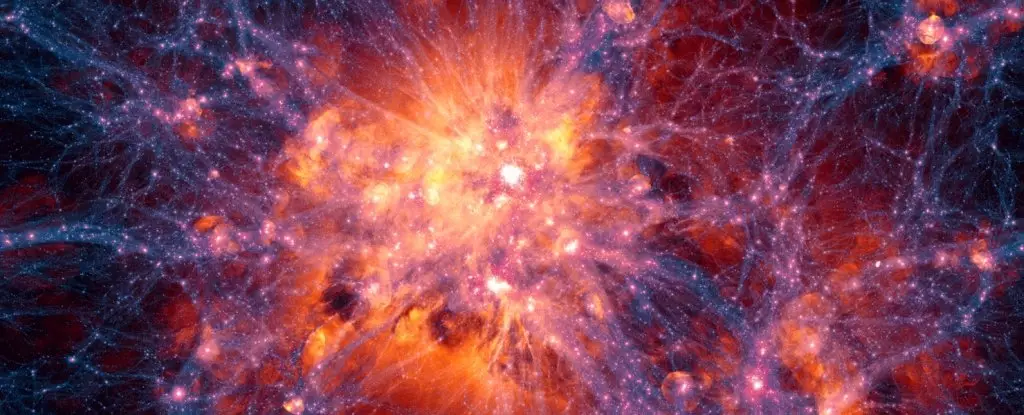The revolutionary principles of general relativity formulated by Albert Einstein in the early 20th century continue to underpin our understanding of the universe. An ambitious initiative led by astronomers using the Dark Energy Spectroscopic Instrument (DESI) has set out to rigorously examine the implications of these principles across a staggering time span—11 billion years of cosmic evolution. The study meticulously maps nearly six million galaxies and provides fresh insights into the gravitational forces that shape the cosmos, validating Einstein’s theories at unprecedented scales.
The remarkable aspect of this extensive analysis is its timing and scale. By investigating the distribution of galaxies throughout a significant segment of the universe’s history, researchers are testing the predictions of general relativity not just in local contexts, but across the grand tapestry of cosmic evolution. This bold examination stands as one of the largest tests of the theory to date, affirming its applicability from the smallest scales to the most expansive facets of the universe.
The Cosmic Web and Gravitational Forces
Gravity is a central force in the universe—its mechanics dictate the movements and interactions of celestial bodies. Despite our understanding of gravity’s nature, its underlying essence remains an enigma. Objects with mass exhibit a tendency to attract each other, and this attraction warps the fabric of space-time around them. Einstein’s general relativity turns gravity into a force that not only binds the cosmos but also structures it in a fluid, intricate web of dark matter.
The DESI collaboration meticulously analyzed how gravity orchestrates this cosmic web over time, mapping the filaments and nodes where galaxies congregate. Initial findings suggest a strong correlation between observed structures and the predictions put forth by general relativity. The beauty of this work lies in its ability to reveal the universe’s haunting gravitational patterns while reinforcing our understanding of fundamental physics.
“General relativity has garnered a wealth of support within solar systems, but its validity on a grand scale warrants investigation,” remarked cosmologist Pauline Zarrouk from the French National Center for Scientific Research. This examination of cosmic structures across billions of years does not merely reaffirm existing theories; it opens pathways for exploring potential discrepancies between general relativity and quantum physics. Identifying cracks in general relativity could illuminate the complex tensions between these two pivotal fields of physics and reveal fresh avenues for understanding the nature of reality.
The data collected thus far indicates that the manifolds of galaxies align with general relativity’s predictions, suggesting that any alteration to gravity—as humans understand it—would drastically change the universe as we recognize it. The findings underscore how intricately nature adheres to Einstein’s framework even as we explore its complexities and limits.
Operational since 2019, the DESI project began surveying galaxies and quasars to get a clearer picture of cosmic evolution and structure. Through a rigorous analysis of its first full year of data, the collaboration provided stunning insights into how the overarching fabric of the universe has evolved. Dragan Huterer from the University of Michigan emphasized the powerful potential of DESI, stating that it not only offers a crucial look into cosmic structure growth but also advances understanding of dark energy models and modified gravity theories.
The detailed examination of 5.7 million galaxies evidences a significant leap in our ability to probe the universe’s architecture. By predicting cosmic web formation with the scientific framework of general relativity, researchers uncovered that the universe behaves consistently with theoretical predictions. This exploration carries implications extending beyond conventional astrophysics; understanding cosmic evolution could address core questions surrounding the enigmatic forces that shape our universe.
Unraveling the Mysteries of Dark Matter and Dark Energy
Among the major mysteries confronting physicists are dark matter and dark energy, which together dominate the universe’s mass-energy content. These two enigmatic entities comprise approximately 95% of the universe, yet their properties and origins remain elusive. Understanding how gravity interacts with these forces can lead to groundbreaking insights into fundamental questions about the nature of existence.
As physicist Mark Maus highlighted, being able to “take pictures of the universe” profoundly impacts our quest to address these fundamental issues. The ongoing analysis through DESI aims to peel back layers on dark matter and dark energy, potentially reshaping our grasp of cosmic forces.
With the completion of the DESI project, researchers anticipate data from over 40 million galaxies and quasars. The final findings may very well offer fresh revelations regarding the universe’s fabric and provide answers to puzzling questions that have persisted for decades. As the community awaits peer-reviewed publications, the implications for technology, understanding cosmic evolution, and the very foundations of physics remain profound.


Leave a Reply